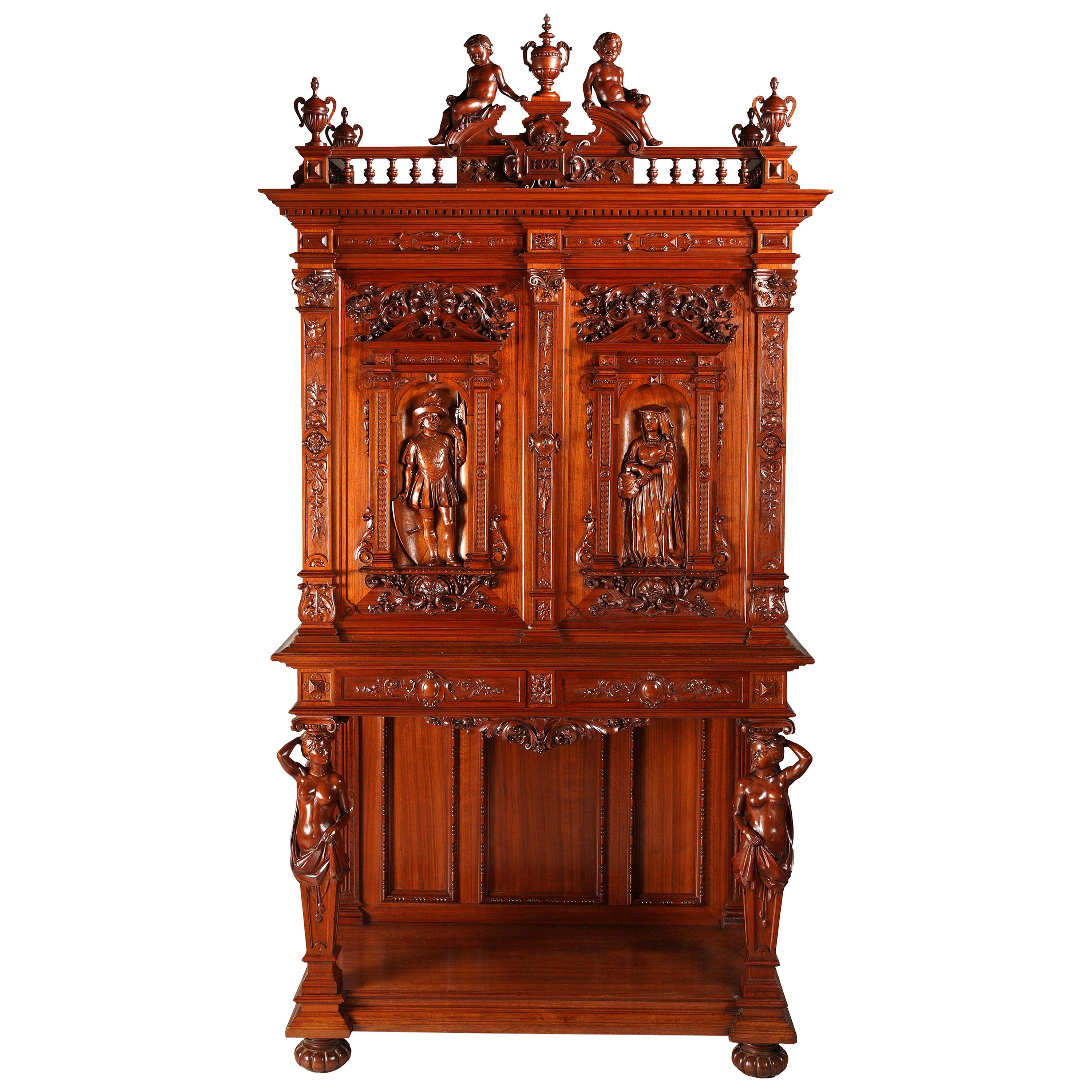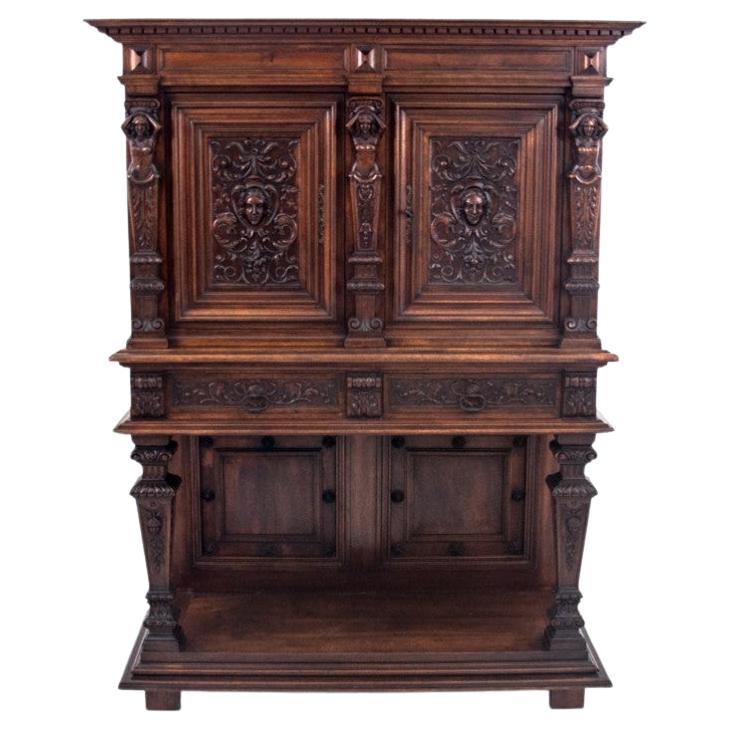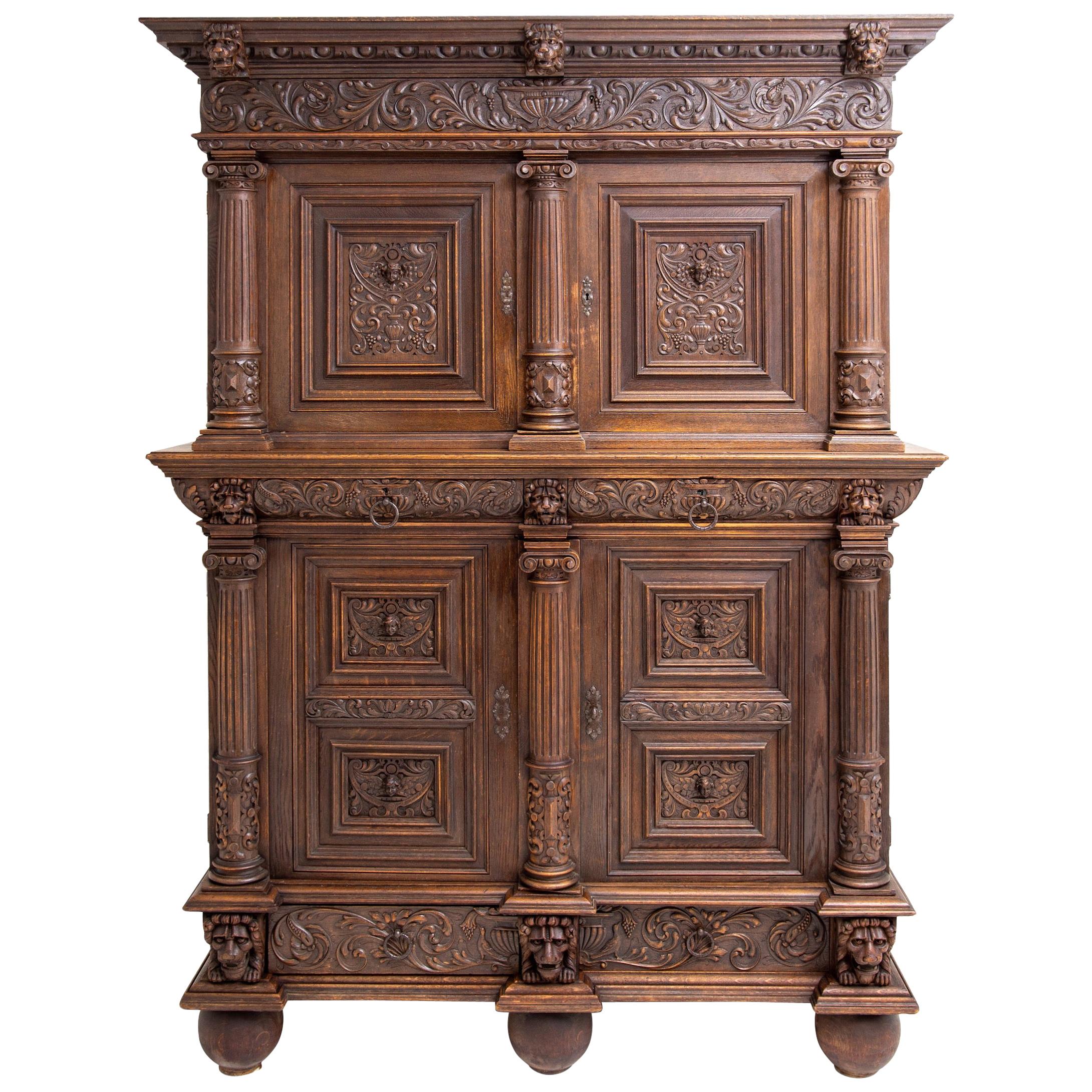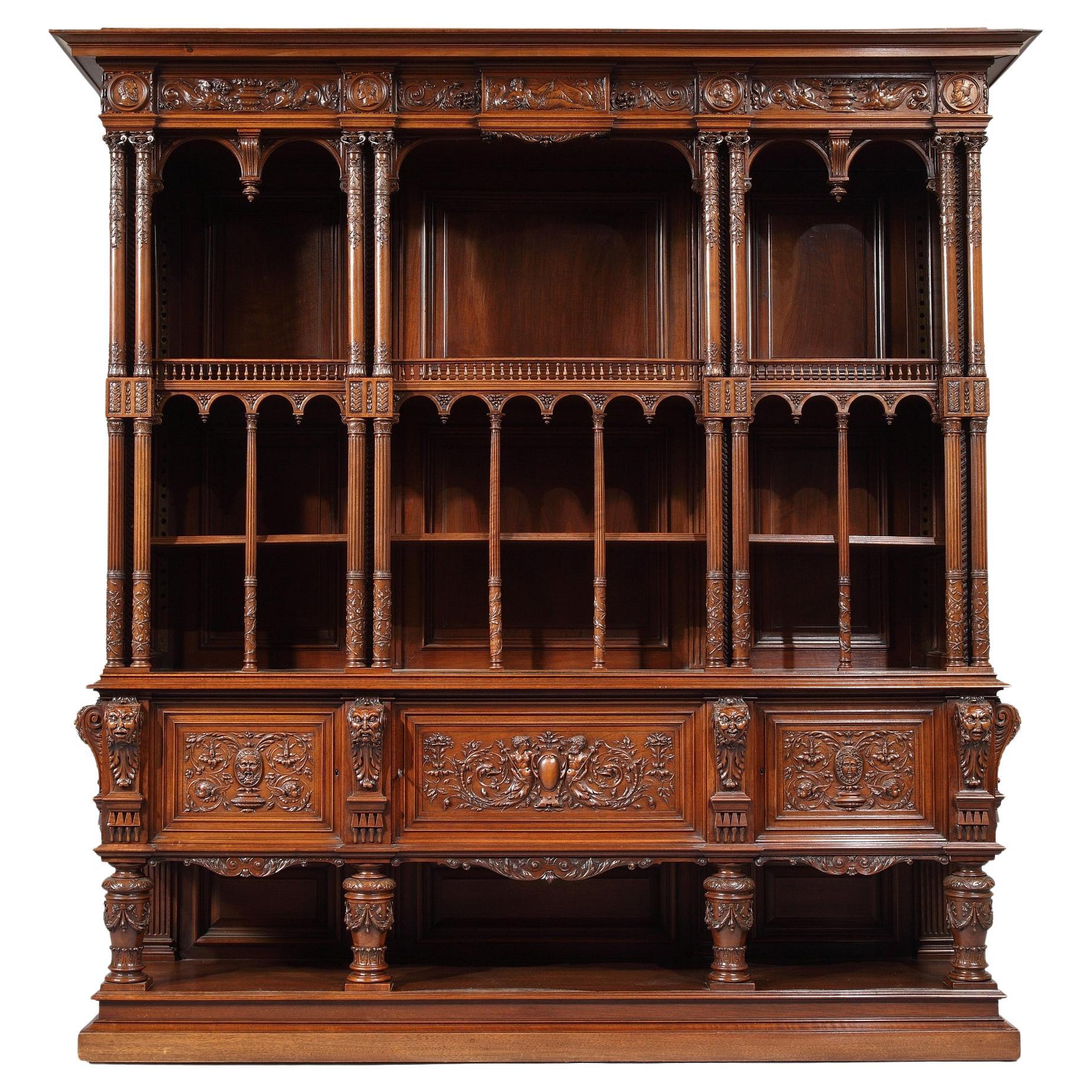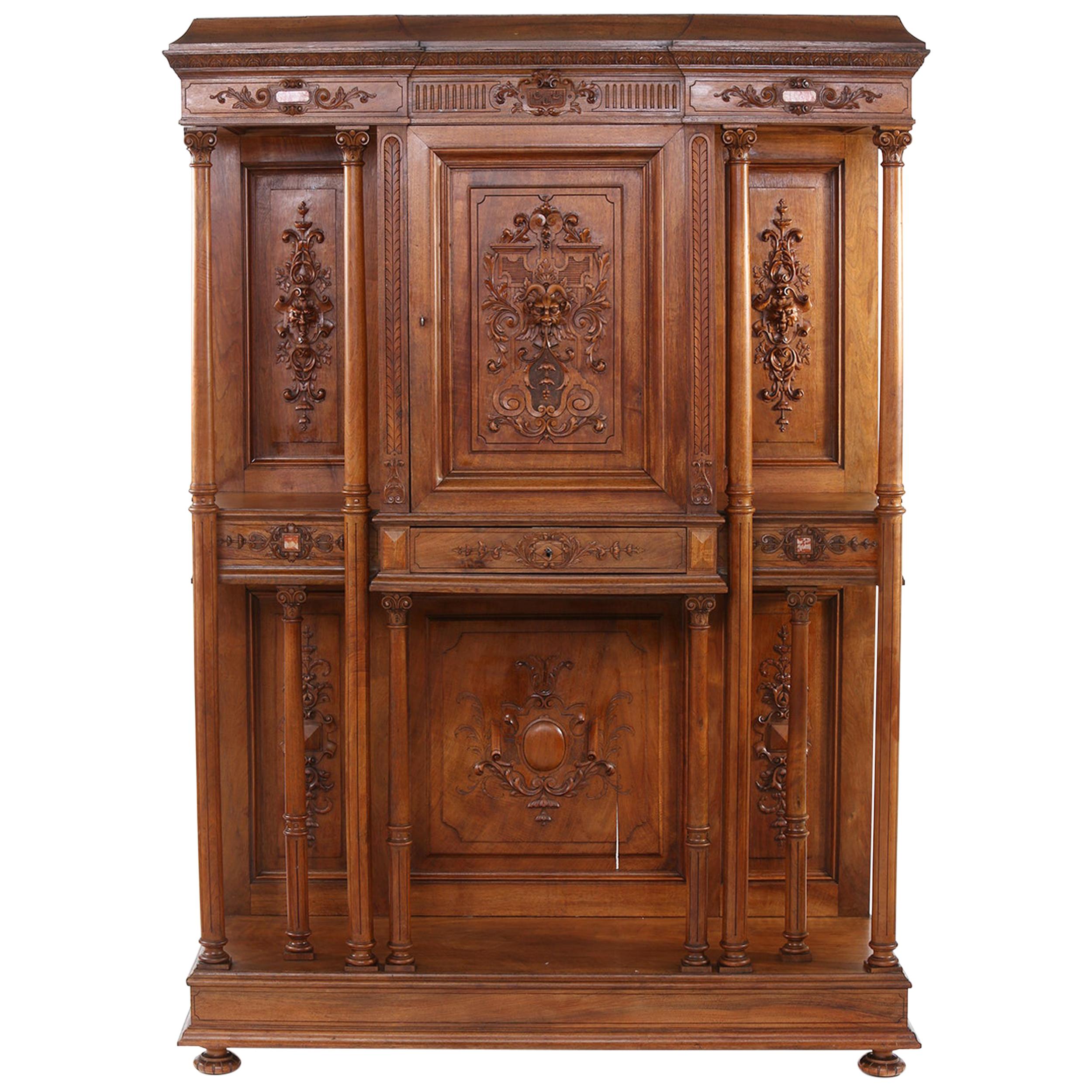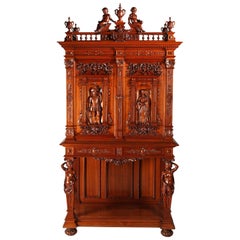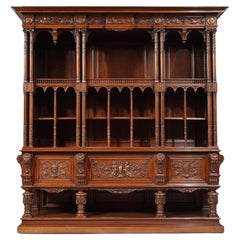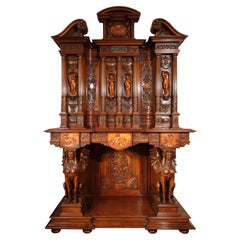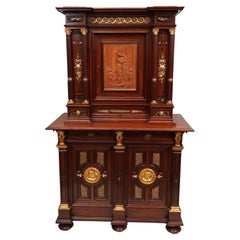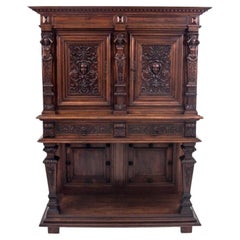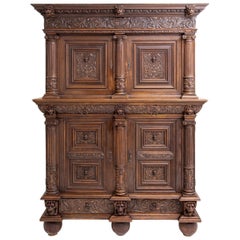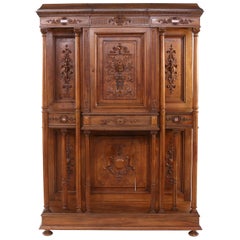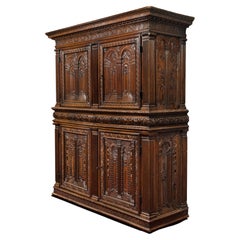Items Similar to Neo-Renaissance Cabinet by G.F. Quignon, Universal Exhibition of Paris 1889
Want more images or videos?
Request additional images or videos from the seller
1 of 21
Neo-Renaissance Cabinet by G.F. Quignon, Universal Exhibition of Paris 1889
$128,978.78
$161,223.4720% Off
£95,375.81
£119,219.7620% Off
€108,000
€135,00020% Off
CA$177,164.86
CA$221,456.0820% Off
A$196,997.15
A$246,246.4420% Off
CHF 103,131.56
CHF 128,914.4520% Off
MX$2,406,357.05
MX$3,007,946.3120% Off
NOK 1,295,949.74
NOK 1,619,937.1720% Off
SEK 1,219,100.44
SEK 1,523,875.5520% Off
DKK 822,336.83
DKK 1,027,921.0320% Off
About the Item
Presented at the Universal Exhibition of Paris in 1889
Important sculpted and engraved natural wood, patinated bronze and Griotte de Campan red marble inlaid Neo-Renaissance style cabinet.
The upper part is composed of a frieze of bronze medallions separated by triglyphs and supported by ribbed columns with Corinthian capitals. There are eight of these columns paired at the front and two simple columns at the rear. The facade presents an alternation of bronzes in niches and cartouches, of marble slates in cartouches sometimes flanked by palmettes, and of engraved motives of laurel and foliage scrolls. The upper part opens with three leaves and three mobile compartments. The belt carved with acanthus leaves opens with two drawers. This cabinet is supported by four richly sculpted tapered feet ending with claws. Four fluted pilasters are inscribed in the moulded back as counterparts. The whole ensemble stands on a moulded plinth and eight rounded feet.
Neo Renaissance Cabinet exhibited at the Universal Exhibition of Paris in 1889. Illustrated in J. Meyer, Great Exhibitions, London, New York, Paris, Philadelphia, 1851-1900, Antique Collector’s Club, 2006, p. 281. (see picture attached)
Gustave-Frédéric Quignon, born in 1843, worked with his father Napoléon Quignon, boulevard Richard-Lenoir. He took the lead in 1874 and expanded the production of the firm with other seats and pieces of furniture, but also with sculpture. Like his father before him, he produced richly carved and gilded Louis XV and Louis XVI style furniture, but also some Neo-Renaissance furniture. He became a supplier of the Mobilier National. He exhibited at the Universal Exhibition in 1878 and won a gold medal. He was a member of the jury at the Universal Exhibition in 1889. The same year, he relocated the firm rue de Saint-Sabin, where he worked until the end of the century. He participated to the French Exhibition of Moscow in 1891, next to H.Dasson and P.Sormani, and to the rapports sur l’Exposition Internationale de Chigago in 1893. He won the Grand Prix for his stand at the Universal Exhibition of 1900.
- Attributed to:Frederic Gustave Quignon (Cabinetmaker)
- Dimensions:Height: 76.38 in (194 cm)Width: 68.12 in (173 cm)Depth: 22.05 in (56 cm)
- Style:Renaissance (In the Style Of)
- Materials and Techniques:
- Place of Origin:
- Period:
- Date of Manufacture:circa 1889
- Condition:
- Seller Location:PARIS, FR
- Reference Number:Seller: 13481stDibs: LU3860316909191
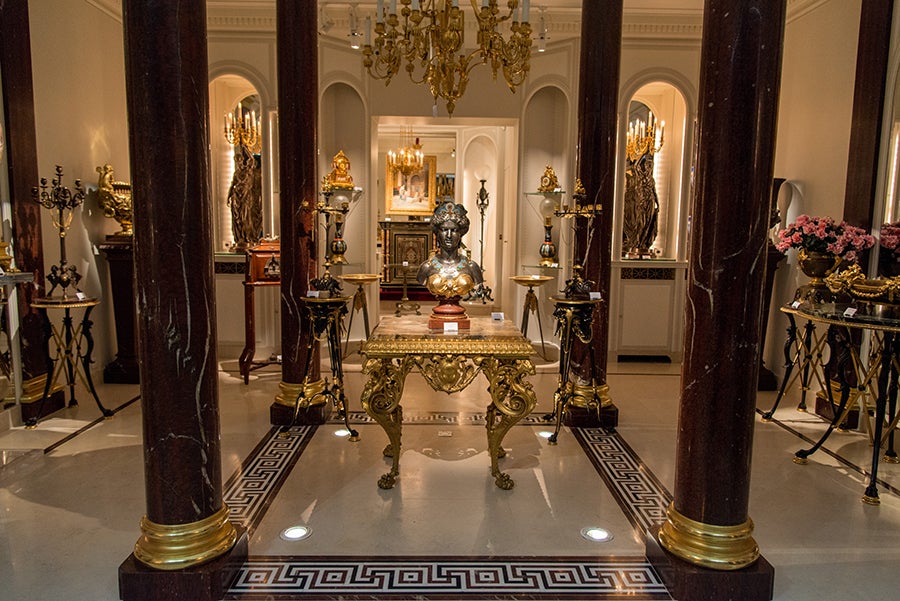
About the Seller
4.9
Vetted Professional Seller
Every seller passes strict standards for authenticity and reliability
Established in 1997
1stDibs seller since 2018
87 sales on 1stDibs
Typical response time: <1 hour
Associations
International Confederation of Art and Antique Dealers' Associations
- ShippingRetrieving quote...Shipping from: PARIS, France
- Return Policy
Authenticity Guarantee
In the unlikely event there’s an issue with an item’s authenticity, contact us within 1 year for a full refund. DetailsMoney-Back Guarantee
If your item is not as described, is damaged in transit, or does not arrive, contact us within 7 days for a full refund. Details24-Hour Cancellation
You have a 24-hour grace period in which to reconsider your purchase, with no questions asked.Vetted Professional Sellers
Our world-class sellers must adhere to strict standards for service and quality, maintaining the integrity of our listings.Price-Match Guarantee
If you find that a seller listed the same item for a lower price elsewhere, we’ll match it.Trusted Global Delivery
Our best-in-class carrier network provides specialized shipping options worldwide, including custom delivery.More From This Seller
View AllRenaissance Style Wooden Cabinet Attributed to H.A. Fourdinois, France, 1893
Located in PARIS, FR
A wooden cupboard, elaborately carved throughout, dated "1893" on the crest and attributed to H.A. Fourdinois. The upper section with a pair of cherubs at the center of a balustrade ornamented with two-handled urns, two architectonic doors below, carved with lady and gentleman in niches surrounded by extensive carving with classical motifs. The lower section with two drawers above a standing female caryatid support at each front corner. The all reposing on four gadronned round feet.
The Fourdinois company was founded in 1835 by Alexandre-Georges Fourdinois (1799-1871). The Universal Exhibition held in London in 1851 was undoubtedly their first great artistic and public success. Winning the Great medal for a neo-Renaissance buffet...
Category
Antique 1890s French Renaissance Cabinets
Materials
Wood
$15,764 Sale Price
40% Off
Renaissance Style Cabinet, France, Circa 1870
Located in PARIS, FR
An outstanding carved cabinet in the Renaissance style. The upper part consists in two stages with arcades, divided in six compartments by rich columns with Corinthian capitals, and topped by a carved entablature. The lower part opens with three doors, ornated with masks, hybrid figures and foliates, and relies on four strong feet.
This cabinet, probably executed for an amateur or a collector, is a perfect model for the neo-Renaissance style, that rose in the 1830’s, in France with the designers Claude-Aimé Chenavard (1798-1838) and Michel Liénard (1810-1870). It came some years after the Gothic Revival, but met a longer success during the 19th century (at the Expositions des Produits de l’industrie in 1844 and 1849, and at the Universal Exhibitions in 1855, 1867 and 1878). Inspiration was found in the French Renaissance, more specifically in the art of Henri II’s reign, and cabinet-makers used dark carved...
Category
Antique 1870s French Renaissance Cabinets
Materials
Wood
Renaissance Style "Four Seasons" Cabinet by M. Lerolle, France, Circa 1890
By Lerolle
Located in PARIS, FR
Signed " Meubles D’Art, M. Lerolle, Fabricant, 61, Rue des Sts-Peres. Paris "
Remarkable carved wood cabinet, richly sculpted in the Neo-Renaissance style, and inlaid with vert de m...
Category
Antique 1890s French Renaissance Revival Cabinets
Materials
Marble
Neo-Renaissance Cabinet by P. Sormani and attr. to E. Lièvre, France, Circa 1870
By Edouard Lievre, Paul Sormani
Located in PARIS, FR
Signed twice on the lock P. SORMANI 10 rue Charlot Paris
Rare neo-Renaissance cabinet in carved wood and Portor marble, adorned with chiseled and gilded bronze.
The upper, part, surmounted by a frieze of posts and marble cabochons, consists of a central door decorated with a carved panel representing the birth of Venus, framed by two pairs of ringed and fluted columns with Corinthians capitals in gilded bronze revealing two doors with secret opening. Two drawers with lion’s head shaped handles and a central drawer decorated with tracery in gilded bronze complete the upper part of this cabinet.
In the lower part, two drawers on the belt with diamond...
Category
Antique 1870s French Renaissance Cabinets
Materials
Marble, Bronze
$64,967 Sale Price
38% Off
Wooden & Enameled Display Sideboard Attributed to H.A Fourdinois, France, c1867
Located in PARIS, FR
Important two-tiered sideboard attributed to H.A. Fourdinois made in natural and carved wood : the lower part made up of four panels, two concave ones and two doors, richly ornated with a polychrome enameled floral decoration and gilt bronze plaques.
A large dual drawer is surmounted by the upper part of the sideboard, opening with two glazed doors, framed by detached columns. The entire unit is topped with a pediment onto which a female bust is carved in relief within a medallion on a gilt background.
With a matching set of twelve chairs.
The Forney library in Paris preserves order registers of the Fourdinois as well as sketches books and pictures representing pieces of furniture made by the Fourdinois workshops. In this documentation, some elements enable us to link this sideboard with Henri-Auguste Fourdinois’ productions, such as the large scrolls linking the upper part to the lower part of the sideboard, as well as the detached columns carved at their lower third. (picture n°1 attached)
Notebook containing ink-sketches coming from the Fourdinois workshop shows a project for a pelmet, beautified with a centering trophy composed of a torch and a quiver within in a foliage wreath, this motif obviously reused by the Fourdinois on the central decoration of the panels of our sideboard. (picture n°2 attached)
The firm of Fourdinois, considered during the Second Empire as the greatest furniture manufacturer in Paris, was founded in 1835 by Alexandre-Georges Fourdinois (1799-1871). It was developped in the context of the Expositions Universelles. At the time, the firm already produces furniture of the Neo-Renaissance style, such as a dresser that won the Great Medal at the London Universal Exhibition of 1851. The son, Henri-Auguste Fourdinois (1830-1907), joined the firm in 1860 and will become head of the firm in 1867. The high quality of his designs was remarked at the Universal Exhibition in 1862, when the jury awarded him two medals « for Excellence of Composition and Execution ». Henri-Auguste, now sole in charge, brought the firm to the summit of its achievements at the 1867 Universal Exhibition in Paris by winning the Grand Prize for his stand. Apart from the commissions he executed for the « Mobilier de la Couronne », he also produced high quality furniture for the Parisian bourgeoisie. The firm is at its zenith during the years 1862-1880. At this time, it is considered as an example to follow for other cabinet-makers, whether they are French, British or American.
Through the quality of execution and the extreme care taken in the decoration of furniture, H.-A. Fourdinois was particularly appreciated by Napoleon III and Eugenie...
Category
Antique 1860s French Renaissance Sideboards
Materials
Enamel, Bronze
Exceptionel Bookcase Forming Desk, by G. Grohé, France, Circa 1860
By Guillaume Grohe
Located in PARIS, FR
Exceptional neo Renaissance bookcase forming desk. This monumental piece consists in a lower part forming drop-front desk supported by two pillars with drawers. The lateral parts each open with a moulded door. The bookcase occupies the upper part, opening by four windows...
Category
Antique 1860s French Renaissance Bookcases
Materials
Wood
You May Also Like
Figural Renaissance cabinet, France, around 1870.
Located in Chorzów, PL
Figural Renaissance cabinet, France, around 1870.
Very good condition.
Wood: walnut
dimensions: width 131 cm x height 175 cm x depth 52 cm
Category
Antique 1870s French Renaissance Cabinets
Materials
Walnut
Neo-Renaissance Cabinet, Late 19th Century
Located in Greding, DE
A four-door cabinet in Renaissance style standing on ball feet with lion's head mascarons and half-columns with volute capitals. The doors with panels and vine decoration are separat...
Category
Antique 19th Century German Renaissance Revival Cabinets
Materials
Wood
19th Century French Renaissance Revival Display Cabinet
Located in Tarry Town, NY
Early 19th century French renaissance revival hand carved walnut with marble inserted reserve display wall cabinet. The cabine...
Category
Antique 1810s French Renaissance Revival Cabinets
Materials
Marble
Important Renaissance Cabinet from Lyon 'France' with a Decor of Perspectives
Located in Saint-Ouen, FR
As soon as 1540 France's second Renaissance is in the making, intimately linked to the rediscovery of the Antique world. The development of the printing and engraving industry allows the spread of artworks and models in many cities and countries. The Italian influence can be perceived in every artistic field. While the French king entrust the most talented Italian artists with major projects such as Il Rosso or Primaticcio in Fontainebleau, French artists also travel to Italy to form themselves to this new style. In Italy they get acquainted with the work of Leo Battista Alberti the first to theorize perspective (De Pictura, 1435-36) and architecture (De re oedificatoria, 1541). Those two publications would have a revolutionary impact on arts.
Furniture is marked by the work of the most famous Italian architects of the time as well as French architects. Indeed Philibert de l'Orme competes with Alberti and by the end of his life publishes several treaties including one devoted to a theory of architecture (1567). Unfortunately he would not live to complete the second volume. In this treaty he expresses his interest for mathematical norms applied to architecture, copied from the Antique. His journeys in Italy allowed him to accumulate the most sophisticated references. Jean Bullant, another architect of great talent also theorizes his practice. He establishes rules characterizing Greco-Roman art staying faithful to Vitruvius.
Following this new inspiration the structure of furniture evolves. From then on appear columns, capitals, cornices, friezes and architraves. The ornamentation uses this inspiration as well with egg-and-dart, palm leaf and rose adorning the most beautiful pieces.
In Lyon, crossroad where meet merchants from everywhere those new experiments are welcomed. Lyon florishing printing industry allows the spreading of models and treaties essential to the artist's work. Thus the first publication of Vitruvius' De Architectura in France would be printed in Lyon in 1532.
Artists from Lyon rediscover and familiarize themselves with the Antique knowledge very early. They adopt those new ideas and use them in their own creations. Lyon cabinet-makers re interpret Antique architecture and Italian Renaissance palaces to give their pieces a pure and harmonious architectural structure. Grooved pilasters are particularly favored. They are topped by capitals of diverse orders always respecting the sequencing with simpler ones for the lower levels and the richest ones on the higher levels. As for the ornamentation, one of the great distinctiveness of Lyon workshops remains the architectural perspective illusions, drawing inspiration from Tuscany.
True masterpiece of the Second French Renaissance this important cabinet illustrates Lyon workshops' taste for fine Italian architecture inspired by Antiquity. An architectural perspective of great quality is treated in symmetry on each panel.
This two-bodied cabinet without recess stands on four rectangular feet. The base comprises a molding, a palm leaf frieze and is bordered by a braid.
The lower body is divided by three grooved pilasters with Tuscan capitals framing two door-leaves. The two panels are encircled by a moudled frame with palm leaves. They are finely carved with a decor of fantasized architecture depicting an Italian Renaissance palace erected symmetrically on each side of a grooved pilaster. On the ground floor a door opens through a stilted arch while the stories are opened with mullioned windows, dormers and occuli. Two large pegged-boss cladded pillars support the entablature enriched by a palm leaf frieze upon which stands an arch whose coffered intrados is centred by a rose. Behind this arch a pyramid appears, standing in front of a second facade with a window topped by a broken curvilinear pediment under a cul-de-four with a shell.
The checker flooring gives depth to the low-reliefs creating vanishing points structuring the panels and guiding the eye of the observer.
A thin laurel braid highlights the belt of the cabinet where are located two drawers. Their facades are adorned by palm leaves in hoops.
The upper body is encircled with palm leaves. The same ternary division as in the lower body appears. However, the pilasters are topped by Ionic capitals with volutes and egg-and-dart. The door-leaves are framed with flowers. On the panels the artist has designed another architectural decor. On the foreground open two arches on top of grooved pilasters with rectangular capitals adorned with palm leaves. The arches are enriched with braids and the coffered intrados bears a decor of roses. The spandrels also bear a flower decor. In the background another arcature hosts a fluted grooved column topped with double basket acanthus capital, characteristic of Corinthian order. The triangular pediment is interrupted by a choux bourguignon.
A large cornice crowns the cabinet. It stands on pilasters and forms an entablature comprising a palm leaf frieze and an egg-and-dart, triglyph and palm leaf cornice.
The cabinet's sides have also been carefully considered. The lower body's panels are enriched with an arch rising above a broken pediment portico hosting a twisted column. Flowers garnish the spandrels. An architectural facade completes the decor. The upper body's panels present two arches supported by a facade opened with dormers and mullioned windows as well as cartouches (one bears the inscription 1580 dating the cabinet) suggesting the interior of an Italian Renaissance palace, confirmed by the chandeliers. The flooring leads our gaze to a second arch with a broken curvilinear pediment where stands a flower vase. This arch opens onto a perspective of another facade along a road.
Inside the cabinet, on the lower body door-leaves appear two designs. On the right door is depicted a Crucifixion. Saint Mary and Saint John flank the Christ on the cross. In the bottom part is inscribed « Dure uiator abis nihil haec spectacula curas / Pendenti cum sis unica cura Deo. / Tota suo moriente dolet natura Magistro. / Nil qui solus eras caussa dolenda doles. ». The signature [Christoff Swartz Monachiensis pinx[it] / Ioa[nnes] Sadeler sculp[it]] tells us it was made by Johan Sadeler I (1550-1600) after Christoph Schwartz (1548-1592). This engraving belongs to an ensemble depicting the Passion of Christ Johan Sadeler executed in 1589 after an altar piece painted by Christoph Schwartz for the private chapel of Renée of Loraine, wife of Duke William V of Bavaria. This altar piece made of nine copper panels has been destroyed during the 19th century. The Crucifixion panel once in the centre of the altar piece is the only one that survived and is today kept in Munich's Alte Pinakothek.
On the left door appears Saint Francis receiving the stigmata. The inscription says : « Signastidomine Servum Tuum. Franciscum. Signis Redemptionis Nostrae ».
This Renaissance cabinet with an architectural decor appearing as much in the structure faithful to Antique rules...
Category
Antique 16th Century European Renaissance Cabinets
Materials
Walnut
Historic cabinet, France, circa 1870.
Located in Chorzów, PL
Historic cabinet, France, circa 1870.
Very good condition.
Wood: oak
height 254 cm x width 150 cm x depth 62 cm
Category
Antique Late 19th Century French Renaissance Sideboards
Materials
Oak
Majestic sideboard, France, ca. 1880.
Located in Chorzów, PL
Majestic sideboard, France, ca. 1880.
Very good condition.
Wood: walnut
Dimensions: height 295 cm width 183 cm depth 65 cm
Category
Antique Late 19th Century French Renaissance Cabinets
Materials
Glass, Walnut
More Ways To Browse
The Great Exhibition Furniture
Antique Renaissance Furniture
Antique Renaissance Cabinets
Medal Cabinet
1851 Exhibition
Fluted Wood Cabinet
Renaissance Paris
Antique Bronze Medallions
1851 Great Exhibition
Expandable Cabinet
French Renaissance Cabinet
Claw Cabinet
Renaissance Neo Furniture
Niche Cabinet
Round Column Cabinets
Antique Wood Niche
Ribbed Cabinet
Red Griotte Marble
